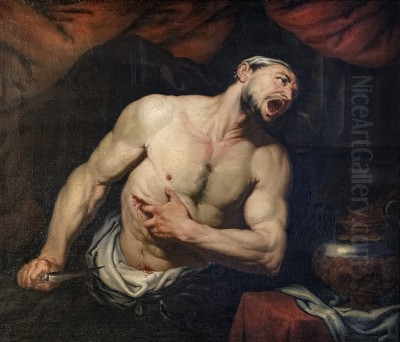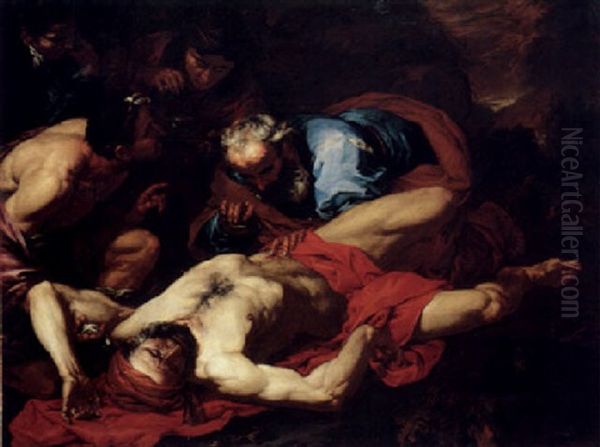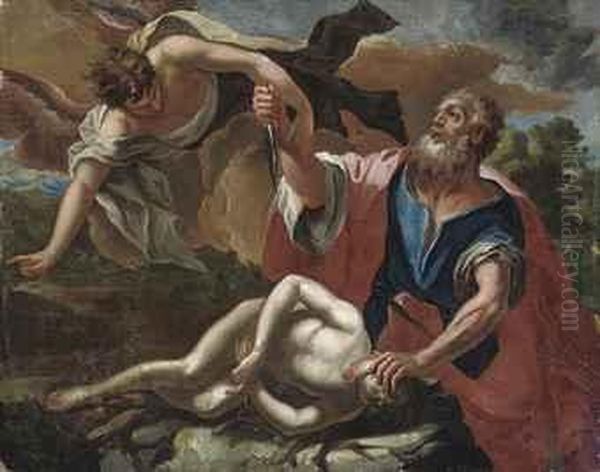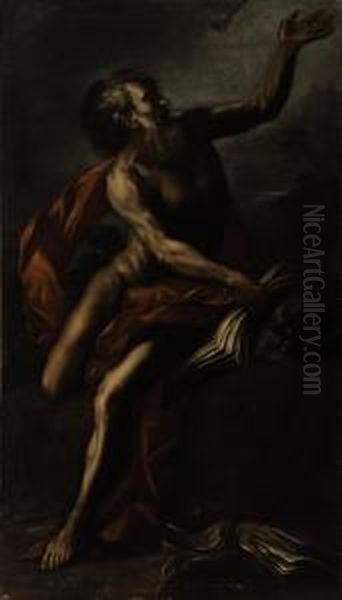
Giovanni Battista Langetti stands as a pivotal figure in the landscape of Italian Late Baroque art. Active primarily in Venice during the latter half of the 17th century, he became one of the most prominent exponents of the Tenebrist style in the city. Born in Genoa in 1635 and passing away in Venice in 1676 at the relatively young age of 41, Langetti carved out a distinct and influential niche with his dramatically lit compositions, intense emotionality, and vigorous brushwork. His legacy is defined by powerful depictions of historical, mythological, and biblical figures, rendered with a raw realism and theatricality that captivated his contemporaries and continues to engage art historians today.
Genoese Origins and Early Artistic Formation
Langetti's artistic journey began in his birthplace, the bustling port city of Genoa. This environment, already rich with artistic exchange, provided the initial backdrop for his development. His formal training commenced under the guidance of Genoese painter Giovanni Francesco Cassana. This early instruction likely grounded him in the fundamentals of drawing and painting prevalent in the local school.
Seeking broader horizons, Langetti also spent time absorbing the artistic currents in Rome. Sources indicate he studied with Pietro da Cortona, a leading master of the Roman High Baroque, known for his grand, dynamic compositions. However, Langetti's artistic temperament seems to have gravitated more strongly towards the dramatic realism and intense chiaroscuro pioneered by Caravaggio and embraced by many Genoese artists, sometimes referred to as the Genoese Caravaggisti. This inclination towards dramatic naturalism, possibly nurtured by exposure to works by artists like Jusepe de Ribera (who, though Spanish, had a profound impact on Italian art, including in Genoa via Naples) and Luca Giordano, would become a defining characteristic of his mature style.
Arrival in Venice and the Embrace of Tenebrism

The decisive move in Langetti's career occurred in the 1650s when he relocated to Venice. La Serenissima, with its own storied artistic traditions, became the primary stage for his artistic output. In Venice, Langetti quickly established himself as a leading figure among the so-called 'Tenebrosi' – painters who specialized in dark, dramatically lit scenes. This style, ultimately deriving from Caravaggio, emphasized stark contrasts between light and shadow (chiaroscuro) to heighten emotional intensity and focus the viewer's attention on the core narrative or psychological state of the figures.
Langetti's interpretation of Tenebrism was characterized by energetic brushwork, a often somber palette punctuated by flashes of light, and a palpable sense of physical presence in his figures. He excelled at creating scenes filled with tension, pathos, and raw human feeling, setting him apart within the Venetian artistic milieu of the time. His arrival injected a new vigor into the Caravaggesque tradition in the city.
Dominant Influences: Caravaggio, Ribera, and Giordano
Langetti's powerful style was not forged in isolation. The influence of Michelangelo Merisi da Caravaggio is undeniable, particularly in the use of dramatic, often artificial-seeming light sources to illuminate figures against dark, undefined backgrounds, and in the commitment to depicting sacred or mythological figures with earthy realism.
Equally significant was the impact of Jusepe de Ribera, the Spanish master active in Naples. Ribera's gritty portrayals of saints, martyrs, and philosophers, often emphasizing their suffering or intense contemplation through rugged features and dramatic lighting, find strong echoes in Langetti's work. Langetti's frequent depiction of aged, sinewy male bodies bears a close resemblance to Ribera's favored subjects.
Furthermore, the influence of Luca Giordano, another Neapolitan-trained artist known for his speed and versatility, is noted. Giordano also worked with dramatic light and shadow, and like Langetti, was adept at creating large-scale, impactful compositions. The connection between Langetti and Giordano might extend beyond stylistic affinity; material analysis of some Langetti paintings, such as Lot and His Daughters, has revealed the use of specific pigments like Pb-Sn-Sb yellow, suggesting shared workshop practices or material suppliers, possibly linking them through the vibrant artistic network that connected Naples, Rome, Genoa, and Venice.
Mastery of Anatomy and the Human Form
A hallmark of Langetti's art is his profound interest in and skillful rendering of the human body, particularly the male physique. His canvases are often dominated by muscular, sometimes contorted figures, depicted with a keen understanding of anatomy. Whether portraying heroes, saints, or philosophers, Langetti used the physical form as a primary vehicle for expressing emotion and narrative drama.

His figures possess a tangible weight and volume, their muscles and sinews often highlighted by the play of light and shadow. This focus on physicality lends an immediacy and visceral impact to his work. He frequently chose subjects – like Hercules, Samson, or suffering saints – that allowed him to explore the extremes of human strength, endurance, and vulnerability through the expressive potential of the body.
Themes of Drama, Philosophy, and Faith
Langetti's subject matter consistently gravitated towards themes that allowed for dramatic and emotional exploration. Ancient history and mythology provided figures like Cato the Younger, whose stoic suicide became a recurring subject, allowing Langetti to delve into themes of principle, despair, and mortality. Philosophers, often depicted in moments of deep contemplation or asceticism, were another favored category, reflecting a Baroque interest in wisdom, introspection, and the human condition.
Biblical narratives, particularly from the Old Testament, offered rich ground for dramatic storytelling. Scenes involving figures like Cain, Lot, Samson, or Saint Jerome were rendered with intense psychological depth and visual force. Langetti also catered to the demand for historical portraits, creating likenesses for private patrons that were reportedly popular in both the Veneto and Lombardy regions. Across all these themes, his consistent aim was to capture moments of heightened emotion and significance.
Signature Works: A Closer Look
Several paintings stand out as particularly representative of Langetti's style and thematic concerns. The Vision of Saint Jerome (c. 1660) exemplifies his approach to religious subjects, likely depicting the saint with dramatic lighting emphasizing his scholarly devotion and ascetic life, a common theme for Tenebrist painters.
The Good Samaritan showcases his ability to handle narrative subjects with emotional resonance and visual clarity, focusing on the compassion and human drama inherent in the parable. The interplay of light would likely highlight the central act of mercy amidst surrounding darkness.
The Suicide of Cato Uticensis (dated by some sources to as early as 1655) is considered a powerful and perhaps peak work. This subject, depicting the Roman Stoic taking his own life rather than submit to Julius Caesar, allowed Langetti to explore themes of political principle, personal resolve, and the stark reality of death. The painting likely features a dramatic composition emphasizing Cato's final moments with intense realism.
Other works frequently associated with him, such as Lot and His Daughters and Cain and his Daughters, further demonstrate his commitment to Old Testament narratives filled with psychological tension and moral complexity, rendered in his signature Tenebrist style. These works underscore his ability to convey complex human relationships and dramatic events through powerful visual language.
Connections and Influence on Later Painters

Langetti was not only influenced by his predecessors and contemporaries but also exerted considerable influence himself, particularly within the Venetian school. His robust style left a mark on the next generation of artists active in the city.
Antonio Zanchi, another Venetian painter, shows clear signs of Langetti's influence in his earlier works. Zanchi adopted the strong chiaroscuro, dramatic compositions, and realistic figure types characteristic of Langetti, before later developing his own distinct style.
Johann Carl Loth, a German painter who spent much of his career in Venice and was also associated with the Tenebrist movement, was similarly influenced by Langetti. Loth's works, including altarpieces created in nearby Padua, often share Langetti's penchant for dynamic figures, dramatic lighting, and emotionally charged scenes. Langetti's impact thus extended beyond native Italians to artists from other parts of Europe drawn to Venice.
Furthermore, Langetti's work invites comparison with other Genoese painters known for their dramatic flair, such as Francesco Fabbrizi and Giovanni Assereto. Situating him within this broader context highlights the interplay between regional schools and the shared currents of the Baroque era.
A Life Cut Short and Enduring Legacy
Giovanni Battista Langetti's prolific career was condensed into a relatively short period. He died in Venice in 1676, only 41 years old. Some accounts describe his life as having elements of misfortune, though specific details are scarce. It is tempting, though speculative, to connect the intense, often tragic or violent themes in his work with a potentially turbulent personal outlook or experiences. His early death undoubtedly cut short a career that was still at its height.
Despite his short life, Langetti left an indelible mark on Venetian painting in the late 17th century. He was a master of the Tenebrist style, infusing it with a particular energy and anatomical focus. His ability to convey raw emotion and physical presence through dramatic light and shadow made him a sought-after artist in his time.

Today, his works are held in prestigious museum collections, including the Cleveland Museum of Art and the National Gallery of Art in Washington D.C., among others. He continues to be recognized by art historians as a key figure in the Italian Baroque, a powerful interpreter of human drama, and a vital link in the chain of Caravaggesque influence that resonated throughout Europe. His paintings remain compelling testaments to the emotional intensity and visual power of Baroque art.